

A Trusted Source For Boating Information Since 2019
Catamaran hulls- everything you need to know.
- Post Written By: Boater Jer
- Published: July 17, 2022
- Updated: July 19, 2022

Disclaimer: You might notice that we recommend products in some articles. We may earn a commission for referring you if you click the link and buy a product.
We only recommend products we’ve tried/tested/own (that’s why you won’t find thousands of affiliate links on my site). If you have experience with one of the products we’ve mentioned, please share your experiences in the comments at the end.
Advertisement

Catamaran hulls are not like normal boats but provide increased stability. Let’s take a look at these incredible boats and how their hulls create one of the most versatile watercraft available today.
The Tamil Cholas used catamarans to ferry their troops to invade Malaysia, Indonesia, and Burma. The early paravars or fishing communities in the southern part of Tamil Nadu used two-hulled boats to fish. Polynesian seafarers were also early users of the catamaran, utilizing the watercraft to get to hard-to-reach islands. ( source )
Although the catamaran hull concept is a relatively new introduction to modern boat design , the boat has been in use since the 5th century. It was used for fishing, traveling, and transporting people and supplies.
Parts Of A Catamaran
Here are the basic parts of the modern sailing catamaran:
- Hulls are what sets this boat apart from the rest. The catamaran has two hulls, while the monohull, as the name suggests, has only one hull. Most of the advantages of this boat are hinged on these two hulls.
- The bridge deck connects the two catamaran hulls.
- On top of the catamaran hulls and the bridge deck is the deck . It is where owners attach most of the equipment in a boat.
- You can locate the berth, the galley, and other living amenities in the cabin .
- The cockpit is where you find the navigation equipment of the boat . It is where you control the catamaran’s rudder, sails, and engine.
Types Of Catamaran
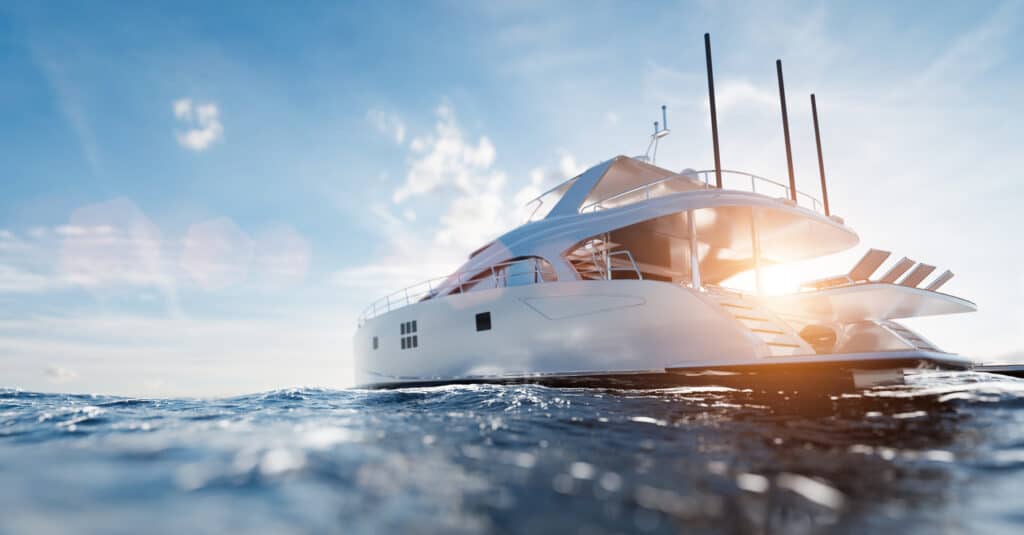
The modern catamaran is far more different than its crude ancestor. Instead of tree cutouts, catamarans are now carbon fiber or fiberglass. Here are the different types of catamarans:

Based On function
Pontoons are usually present on rivers and lakes and sometimes even on oceans, but they only travel near the shore.
In a catamaran pontoon-type boat, the pontoons serve as storage areas, where you will find the onboard motors. They are useful for water leisure activities such as short water trips, tubing, wakeboarding, and water skiing.
Some pontoons may also serve as houseboats. They provide a broader, more stable platform ideal for a floating house. Plus, the space is bigger, and most of it is above water. It offers a better viewing option than a monohull. ( Source )
Small Waterplane Area Twin Hull is a catamaran-type boat that the United States Navy initially used for military purposes. They provide the water stability that is necessary when transporting heavy military equipment.
One example of a military SWATH catamaran is the Spearhead class EPF. It is as long as a World War II escort destroyer, yet it is twice as fast at 43 knots. It can reach that speed because of its two separate hulls.
Because of their innate speed, SWATH catamarans can become patrol boats in lakes and rivers. They can easily outrun and outmaneuver standard watercraft.
Nowadays, there are SWATH cruise ships and other non-military variations. ( Source )

Based On Design
- Sailing Catamaran
The smaller sailing catamarans do not have auxiliary engines, so the owner can propel the boat by harnessing the wind using the sails. It’s a popular choice for people with very little or no sailing experience because they are light and easy to use.
The larger sailing catamarans are for group charters and long-distance cruising. They have become so popular lately that they now outnumber monohulls in tropical locations all over the world. They have a last, a headsail, and a mainsail. And the twin hulls have one engine each.
- Power Catamaran
Unlike their sailing cousins, the powered catamarans do not have sails. They have massive engines which provide high speed. Their twin hulls are stronger and can carry and protect the large motors.
The smaller “powercats” are used mainly for fishing. The bigger ones are rented out for charters and cruises.
Catamaran Hulls Performance
Thanks to the catamaran hulls, the boat offers many advantages over other boat types.
- Because its dual-hull design provides a broader base, it offers more water stability than monohull boats. It makes the cat (catamaran) a popular choice for fishing expeditions and cruises.
- Riding a catamaran is ideal for people who feel seasick whenever they ride boats. The twin hulls prevent the boat from moving from side to side. The hulls allow the boat to travel smoothly, even on moderately choppy waters.
- The catamaran is the best choice when storing provisions and other household items with less heeling and bobbing.
- The twin hulls’ stability is ideal for many activities such as cooking and partying.
- Cats offer more moving space because of their broader base, thanks to dual hulls.
- With a catamaran, you have two great options on where to hang out. You can do it on the spacious deck or below the galley.
- Compared to a monohull of the same size, the catamaran can accommodate more equipment and people.
- The living area in a catamaran is above the water line. This feature provides more natural light, a greater view of the outside, and better air circulation.
- Since catamarans do not have keels, they can anchor on shallow waters, something that most monohulls will not be able to do. This ability of catamaran boats is impressive, especially if you are going around areas with many reefs and small islands.
- Catamaran hulls allow the boat to cut through the waves easier and faster. It means they require less engine power than their monohull counterparts.
- Because it has two engines and two rudders, the catamaran can easily maneuver in very tight spaces.
- Because they do not carry heavy keels, catamarans can sail faster than monohulls.
- The catamaran’s stability, speed, and weight make it a safer option than the monohull. It can sail in shallow waters, make a 360 degrees maneuver effortlessly, and carry more provisions.
Disadvantages Of A Catamaran
Like any other boat type, the catamaran also has drawbacks and limitations. Here are some of them:
- The catamaran hulls prevent the boat from sailing as fast as the monohull upwind. The two hulls cause drag, and this slows the boat considerably.
- Because of its bigger size, looking for a docking site can be more difficult and costlier than a monohull.
- For hardcore sailing fans, the experience of sailing with a catamaran will never be able to match that of sailing with a monohull. To them, the challenge of true sailing is just not there with a catamaran.
What Are The Hulls Of The Catamaran Called?
According to the Online Etymology Dictionary, the Tamil word கட்டுமரம், which is pronounced as kattumaran, is where the word catamaran takes its name. The word means “pieces of logs tied together”. Through the years, the term has evolved into what is now a catamaran in English.

What Are The Characteristics Of A Catamaran Hull?
- Both hulls of a catamaran complement each other to achieve very minimum water resistance.
- Because of this, it takes less energy to propel a catamaran, whether via an engine or sails.
- The catamaran hulls provide stability to the boat. The twin-hull significantly reduces bobbing.
- The catamaran’s ability to keep steady on the water makes it an ideal vessel for cooking, dining, and storing provisions.
Are Catamarans Good In Rough Water?
Catamarans are amazingly stable in rough water. The catamaran’s design and build, which provides stability, are factors why it is one of the best boats to use when the waters are choppy.
Yes, catamarans are relatively more expensive than monohulls. Nevertheless, since single-hull boats are less expensive, their resale value is also cheap.
If you add all the advantages that a catamaran offers – safety, comfort, and speed- it does not come out expensive.
patekphilippe.io

Share this post with your friends
Subscribe to our newsletter.
Join us in our love for all things water. And Adventure.
A Snapshop Guide To Boat Buying
Advertisement A Guide to Buying Boats for a Smooth Sailing Adventure Looking for the ideal boat can feel like an arduous adventure. To begin your boating journey, a boat must be suitable for your requirements in terms of the quantity and quality of its lodgings, speed, maneuverability, overall look, and affordability based on your budget.
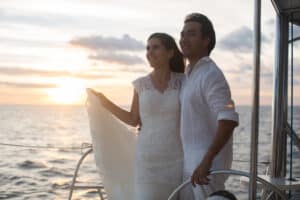
Best Cruising Catamarans For Couples
Advertisement Looking for the best cruising catamarans for couples? Are you looking for the best spot to spend your holiday as a couple? If you want to spend a little time with someone you care about, keep reading because you are in the right place. Among the well-known cruising catamaran patronized by couples is the

Who Makes Each Brand of Catamaran and Where They’re Built
Advertisement Boating Guide Presents: Who Makes Each Brand of Catamaran and Where They’re Built. Catamarans are gaining popularity among seasoned sailors. Their speed and reliability made them the top choice for family cruises and long distances voyages. Let’s dig deeper into their fabrication, shall we? Among the acclaimed Catamaran brands is Lagoon, Privilege, Gemini, Bali,

Do Flat Bottom Boats Have Titles?
Advertisement Have you ever wondered if Flat Bottom Boats have titles? It’s a perfectly valid question, and essential to know if you plan on purchasing a flat bottom boat or already own one. Or maybe you have a different kind of boat and are wondering about the need for a title? A title is a

Can Sailboats Go Against The Wind? Here’s How!
Advertisement Can sailboats go against the wind? Let’s find out! There is a saying that you can’t change the direction of the wind and would have to adjust your sail; how true of it. One cannot alter the wind’s current by will or any other method; that is why one should adjust their sail accordingly.

How Long Does A Kayak Last? 5 Awesome Materials Examined
Advertisement If you’re wondering: “How long does a kayak last?” you’ve come to the right place for answers about kayaks of various materials. Kayaks and canoes are expensive things. Some cost hundreds of dollars, so it is understandable to want your investment to last for a lengthy period. Some investigation is required to establish the

Boat Information By Type
© 2023 Boating.Guide, A Hyperwave Media Group Ltd. Publication.
Privacy Overview
Did You Know That We Offer Contract to Closing Services? Click Here to Find Out More.
Need Marine Financing? Apply Here With Our Partner, First Approval Source
- Catamaran Interviews
- Catamaran Reviews
- Buying Advice
- Selling Advice
- Woods Design Advice
- Americat 3014
- Aquila 44 Yacht
- Balance 526
- Bali 40 Catspace
- Beneteau Blue II
- Broadblue 346
- Broadblue 38 Prestige
- Broadblue 385
- Broadblue 435
- Broadblue 46
- Catalac 10M
- Catalac 11M
- Catalac 12M
- Catalac 900
- Catana 42 S
- Chris White 48 Voyager
- Chris White 55
- Corsair F28 R
- De Villiers
- Dolphin 460
- Endeavour 30
- Endeavour 35 Victory
- Endeavour 36
- Endeavour 44
- Endeavour 44 TrawlerCat
- Fortuna 36 Island Spirit
- Fortuna 401 Island Spirit
- FP 32 Maldives
- FP 35 Tobago
- FP 37 Antigua
- FP 38 Athena
- FP 39 Fidji
- FP 40 Lavezzi
- FP 40 Lucia
- FP 40 Summerland MY
- FP 41 Lipari
- FP 42 Astrea
- FP 42 Venezia
- FP 43 Belize
- FP 44 Helia
- FP 44 Orana
- FP 46 Bahia
- FP 46 Casamance
- FP 48 Salina
- FP 56 Marquises
- FP 57 Sanya
- FP 60 Eleuthera
- FP Saona 47
- Gemini 3000
- Gemini 3200
- Gemini 3400
- Grainger 420 Mystery Cove
- Hirondelle 7M
- Lagoon 37 TPI
- Lagoon 42 TPI
- Lagoon 43 PC
- Leopard 39 PowerCat
- Leopard 45 Classic
- Leopard 47 PowerCat
- Leopard 51 PowerCat
- Leopard 53 PowerCat
- Maine Cat 30
- Maine Cat 41
- Matrix 450 Vision
- Matrix 760 Silhouette
- Maverick 400
- Maverick 420
- Maverick 440
- Nautitech 40
- Nautitech 442
- Nautitech 46 Open
- Nautitech 47
- Outremer 40
- Outremer 45
- Outremer 50 Standard
- Outremer 55
- Privilege 37
- Privilege 39
- Privilege 42
- Privilege 43
- Privilege 435
- Privilege 45
- Privilege 465
- Privilege 48 Transcat
- Privilege 482
- Privilege Serie 5
- Prout 31 Quest
- Prout 33 Quest
- Prout 34 Event
- Prout 35 Snowgoose
- Prout 37 Snowgoose
- Prout 37 Snowgoose Elite
- Prout 38 Manta
- Prout 39 Escale
- Royal Cape 45
- Royal Cape 530 Majestic
- Royal Cape Majestic 500
- Sailcraft 30 Iroquois
- Sailcraft 32 Comanche
- Sailcraft 35 Cherokee
- Sailcraft 41 Apache
- Sailcraft 44 Apache
- Wildcat 350
- Seawind 1000
- Seawind 1160
- Seawind 1200
- Seawind 1260
- Seawind 1600
- Solaris 36 Sunrise
- Solaris 36 Sunstar
- St Francis 44
- St Francis 48
- St Francis 50
- Stealth 11.8
- Heavenly Twins 26
- Ocean Twins 38
- Voyage 380 Maxim
- Voyage 400 Norseman
- Voyage 430 Norseman
- Voyage 450 Cabriolet
- Voyage 47 Mayotte
- Wharram 38 Tiki
- AMI 320 Renaissance
- Woods 22 Wizard
- Woods 35 Banshee
- Woods 35 Flica
- Woods 36 Scylla
- Woods 36 Vardo
- Woods 38 Transit
- Woods 40 Meander
- Xquisite X5
- Xquisite X5+
Catamaran Hull Design
- Post author By Rick
- Post date June 29, 2010
- 2 Comments on Catamaran Hull Design

Part 1: Notes from Richard Woods
Since the America’s Cup experimented with going multihull, there’s been a lot of interest in catamaran performance and the catamaran hull designs that define performance. Many guys are investigating whether to buy a catamaran or design and build their dream boat. Let it be said here that building a large catamaran is not for the faint of heart. People begin building 100s of boats a year, yet few are ever completed, as life always seems to have a way of interfering with a good boat build.
Never the less, since the rest of this website is about selecting and buying a boat , it only seems fair to have at least one webpage that covers catamaran design. This page contains notes on boat hull design goals and an accompanying page from Terho Halme has mathematical formulas used in actual catamaran hull design. It has become a popular research stop and an important reference to the catamaran design community.
The content of this page was reproduced from the maestro of Catamaran designs, renown British naval architect, Richard Woods, who not only designs catamarans, he sails them across oceans…. repeatedly. He has a lot to say on the subject of catamaran hull design.
“…When it’ all said and done, the performance of a sailing catamaran is dependent on three primary specs: length, sail area and weight. If the boat is longer it generally means it’ a faster boat. If she has more sail area, it means she’ a faster boat and if she’ light it means she’ a faster boat. Of course, there are limits: Too much sail area capsizes the boat in brisk winds. If the boat is designed too light, she will not take any kind of punishment. Too slim a hull design and the boat becomes a large Hobie Cat capable of only carrying your lunch. Of course, too long and large and you’d have to be Bill Gates to afford one. Then there are lot of additional and very important factors like underwater hull shape, aspect ratios of boards and sails, wet deck clearance, rotating or fixed rigging and so on….” Richard Woods
All Catamarans are not equal, but all sailboats have two things in common: They travel on water and they’re wind powered, so the Catamaran design equations in the 2nd part should apply to every catamaran from a heavy cruising Cat to a true ocean racer.
Richard Wood’s comments on catamaran design:
We all know that multihulls can be made faster by making them longer or lighter or by adding more sail. Those factors are the most important and why they are used as the basis of most rating rules. However using just those figures is a bit like determining a cars performance just by its hp and curbside weight. It would also imply that a Tornado would sail as fast forwards as backwards (OK, I know I just wrote that a Catalac went faster backwards than forwards)
So what next?? Weight and length can be combined into the Slenderness Ratio (SLR). But since most multihulls have similar Depth/WL beam ratios you can pretty much say the SLR equates to the LWL/BWL ratio. Typically this will be 8-10:1 for a slow cruising catamaran (or the main hull of most trimarans), 12-14:1 for a performance cruiser and 20:1 for an extreme racer.
So by and large faster boats have finer hulls. But the wetted surface area (WSA) increases proportionately as fineness increases (for a given displacement the half orange shape gives the least WSA) so fine hulls tend to be slower in low wind speeds.
The most important catamaran design hull shape factor, is the Prismatic Coefficient (Cp). This is a measure of the fullness of the ends of the hull. Instinctively you might think that fine ends would be faster as they would “cut through the water better”. But in fact you want a high Cp for high speeds. However everything is interrelated. If you have fine hulls you can use a lower Cp. Most monohulls have a Cp of 0.55- 0.57. And that is about right for displacement speeds.
However the key to Catamaran design is you need a higher Cp if you want to sail fast. So a multihull should be at least 0.61 and a heavy displacement multihull a bit higher still. It is difficult to get much over 0.67 without a very distorted hull shape or one with excessive WSA. So all multihulls should have a Cp between 0.61 and 0.65. None of this is very special or new. It has been well known by naval architects for at least 50 years.
There are various ways of achieving a high Cp. You could fit bulb bows (as Lock Crowther did). Note this bow is a bit different from those seen on ships (which work at very specific hull speeds – which are very low for their LOA). But one problem with them is that these tend to slam in a seaway.
Another way is to have a very wide planing aft section. But that can increase WSA and leads to other problems I’ll mention in a minute. Finally you can flatten out the hull rocker (the keel shape seen from the side) and add a bustle aft. That is the approach I use, in part because that adds displacement aft, just where it is most needed.
I agree that a high Cp increases drag at low speeds. But at speeds over hull speed drag decreases dramatically on a high Cp boat relative to one with a low Cp. With the correct Cp drag can be reduced by over 10%. In other words you will go 10% faster (and that is a lot!) in the same wind and with the same sails as a boat with a unfavorable Cp. In light winds it is easy to overcome the extra drag because you have lots of stability and so can fly extra light weather sails.
The time you really need a high Cp boat is when beating to windward in a big sea. Then you don’t have the stability and really want to get to your destination fast. At least I do, I don’t mind slowly drifting along in a calm. But I hate “windward bashing”
But when you sail to windward the boat pitches. The sea isn’t like a test tank or a computer program. And here I agree with Evan. Immersed transoms will slow you down (that is why I use a narrower transom than most designers).
I also agree with Evan (and why not, he knows more about Volvo 60 design than nearly anyone else on the planet) in that I don’t think you should compare a catamaran hull to a monohull, even a racing one. Why chose a Volvo 60/Vendee boat with an immersed transom? Why not chose a 60ft Americas Cup boat with a narrow out of the water transom??
To be honest I haven’t use Michelet so cannot really comment. But I have tested model catamarans in a big test tank and I know how inaccurate tank test results can be. I cannot believe that a computer program will be better.
It would be easy to prove one way or the other though. A catamaran hull is much like a frigate hull (similar SLR, L/B ratios and Froude numbers) and there is plenty of data available for those. There is also a lot of data for the round bilge narrow non planing motorboats popular in the 1930’-50’s which again are similar to a single multihull hull.
One of the key findings I discovered with my tank test work was just how great the drag was due to wave interference between the hulls. Even a catamaran with a modern wide hull spacing had a drag increase of up to 20 % when compared to hulls at infinite spacing. One reason why just flying a hull is fast (the Cp increases when you do as well, which also helps). So you cannot just double the drag of a single hull and expect to get accurate results. And any speed prediction formula must include a windage factor if it is to give meaningful results.About 25 years ago we sailed two identical 24ft Striders next to each other. They were the same speed. Then we moved the crew of one boat to the bow. That boat IMMEDIATELY went ½ knot faster. That is why I now arrange the deck layout of my racing boats so that the crew can stay in front of the mast at all times, even when tacking or using the spinnaker.
I once raced against a bridge deck cabin catamaran whose skipper kept the 5 crew on the forward netting beam the whole race. He won.
Richard Woods of Woods Designs www.sailingcatamarans.com
- Tags Buying Advice , Catamaran Designers

Owner of a Catalac 8M and Catamaransite webmaster.
2 replies on “Catamaran Hull Design”
I totally agree with what you say. But Uli only talk sailing catamarans.
If only solar power. You need the very best. As limited watts. Hp.
The closer to 1-20 the better.
Closing the hulls to fit in cheaper marina berth. ?
You say not too close. But is that for sailing only.
Any comment is greatly appreciated
Kind regards Jeppe
Superb article
Leave a Reply Cancel reply
Your email address will not be published. Required fields are marked *
Save my name, email, and website in this browser for the next time I comment.
- 2024 BOAT BUYERS GUIDE
- MIAMI BOAT SHOW
- Email Newsletters
- Fishing Boat Reviews
- Fly Fishing
- Marine Electronics
- Fishing Tackle
- Best Marine Electronics & Technology
- Fishing Destinations
- The Bahamas Fishing Guide
- Boating Safety

2023 Boat Buyers Guide: Catamarans
- By Karl Anderson
- December 27, 2022
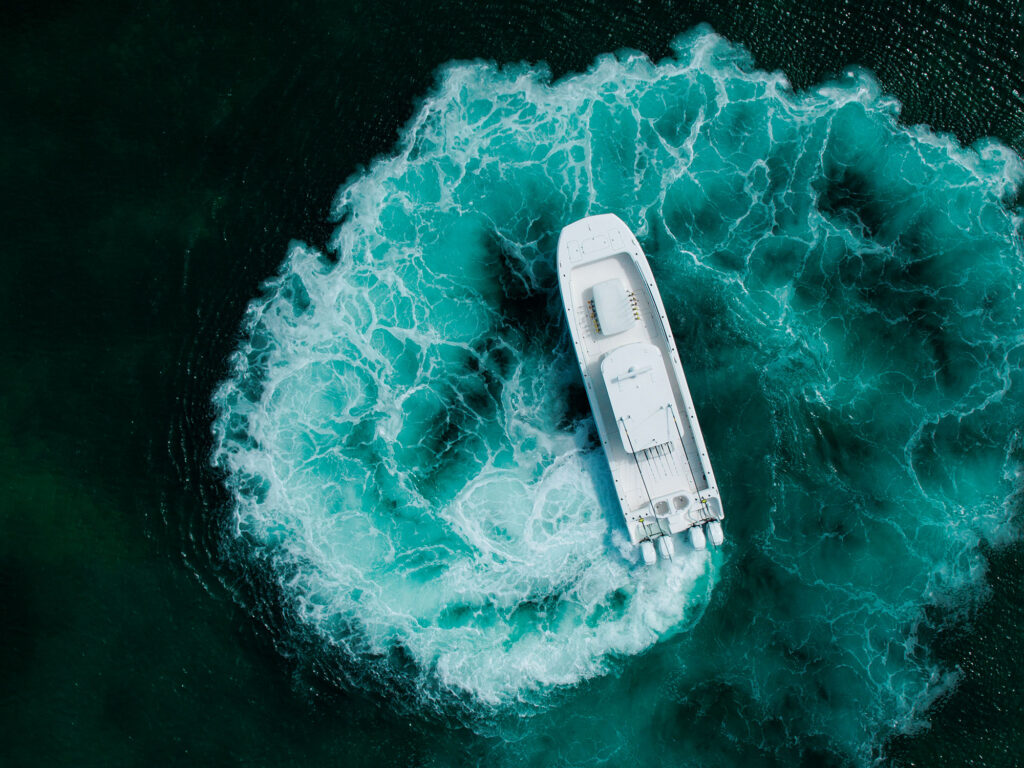
The popularity of the multihull (aka catamaran or cat) fishing boats has never been greater, as more and more boatbuilders enter this growing segment of the market. The inherent stability of the catamaran design rolls less with the seas, making fishing offshore less tiresome and more comfortable. Available from 20 to 48 feet, catamarans typically offer a large fishing platform with generous storage and fishing amenities. They are available in a wide variety of deck layouts, including center-consoles, dual-consoles, and even pilothouse and express variants.
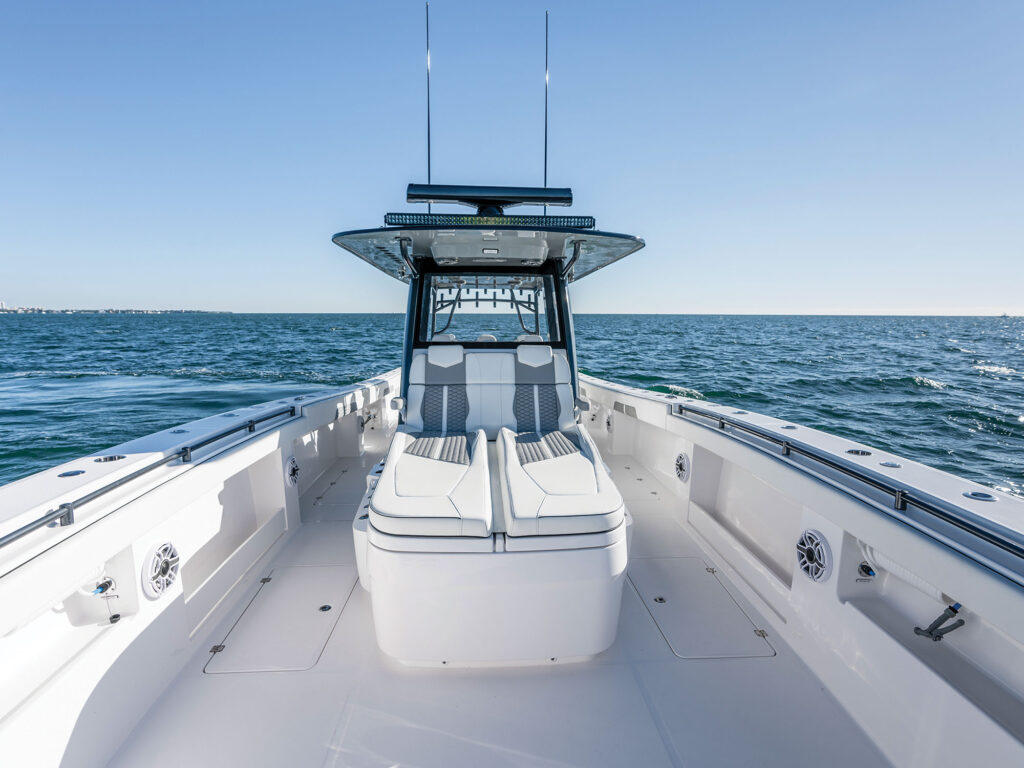
Big Picture
The large deck area of a catamaran enables many large underdeck storage lockers and insulated fish boxes in the sponsons. This gives anglers ample room for gear and the day’s catch. The catamaran’s stability, fishability, and smooth ride in rough seas make it attractive to anglers as well as day-cruisers. A center-console version adds 360 degrees of angler access to the rail. With the dual-console design, generous seating behind a beam-to-beam windshield makes for a great family fishing-friendly setup.
Live bait is one of the most popular types of fishing in virtually every coastal zone. To do it successfully requires optimal water capacity and proper flow. The minimum size of the outflow water plumbing should be twice the size of the inflow. The plumbing should have a drain at the bottom to shed scales at the end of the day, as well as a drain at the top of the well to adjust capacity and allow overflow. Above-deck transom-mounted wells should fully flood to the lids when running to keep baits from getting beat up.
Tip: A sump box with multiple pumps in case a pump fails is the best setup for first-rate livewells. Conveniently located inflow and outflow valves make it easy to optimize the flow without tiring your bait from swimming too much in the well.
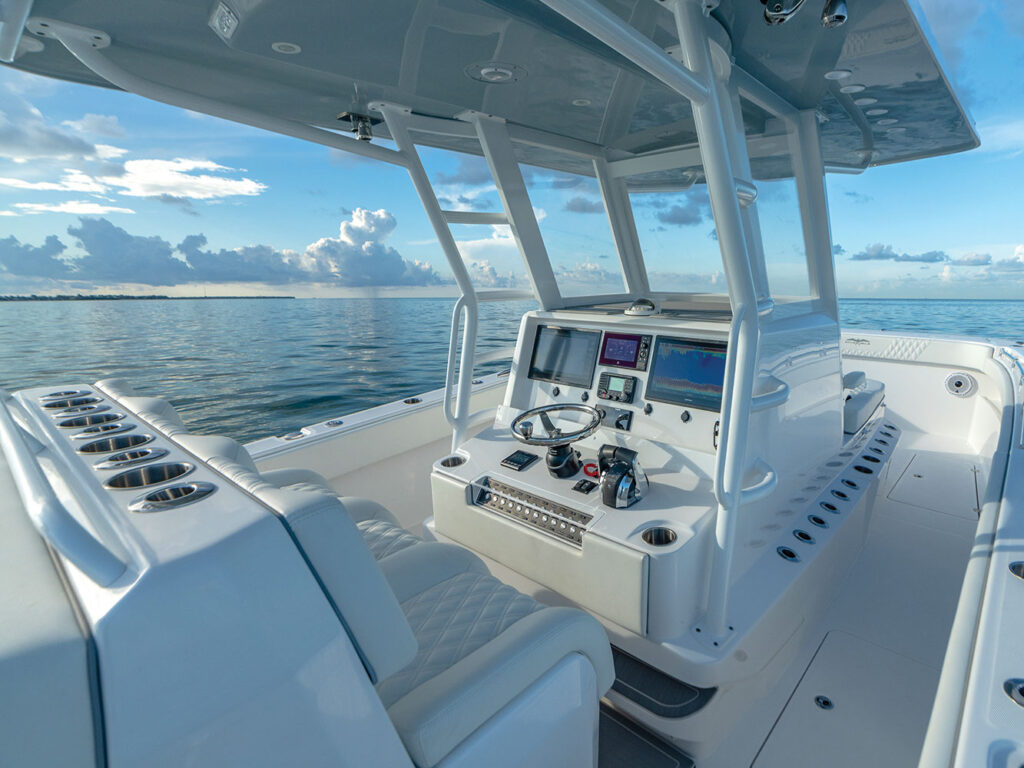
Rod Storage
Having enough rod holders is essential to be successful for opportunity fishing. Look for vertical rod storage along the console and across the back of the T-top. Many models also have rod holders along the outboard transom wall. Having plenty of gunwale rod holders for drift- and kite-fishing is helpful.
Tip: Placing adjustable swivel rod holders by Gemlux makes deep-dropping, lure-fishing and drifting even easier because they allow your rods to face the direction the baits are fishing, yet they can be swiveled back to keep rods from sticking out of the boat while running and docking.
Manufacturers often offer multiple choices for horsepower, but whatever the choice, the engines must come in pairs. For example, you might order twin outboards (one for each sponson) or four outboards (two for each sponson), but single- or triple-outboard configurations are not common on a cat. Optimal selection should be made based on user load, weight of the boat, ride comfort , performance desires, and best case for resale. It’s a rare day when you can run wide open, but having more horsepower gives better torque at slower speeds and thus better control. Running larger engines slower gives better fuel efficiency too.
Tip: When possible, choose the highest horsepower offered because it typically leads to a better resale value with a shorter sales cycle.
Power steering from engine manufacturer Optimus or SeaStar is essential with the higher horsepower required for larger boats, and it makes installing and operating the upper station in a tower far more practical and comfortable.
With the power demands of electronics, livewell pumps, stereo amps and more, it is wise to have at least two house batteries, and for larger boats, a third or fourth with a multibank charger for dockside. Each engine should have its own dedicated battery as well.
Electronics
Typically choosing the largest screen or multiple screens that will fit on the console is best-case scenario for ease of use, ergonomics, and visibility. VHF radios, stereo controller, and equipment switches for lighting, pumps, and accessories should all be integrated with greatest visibility and ease of operator reach.
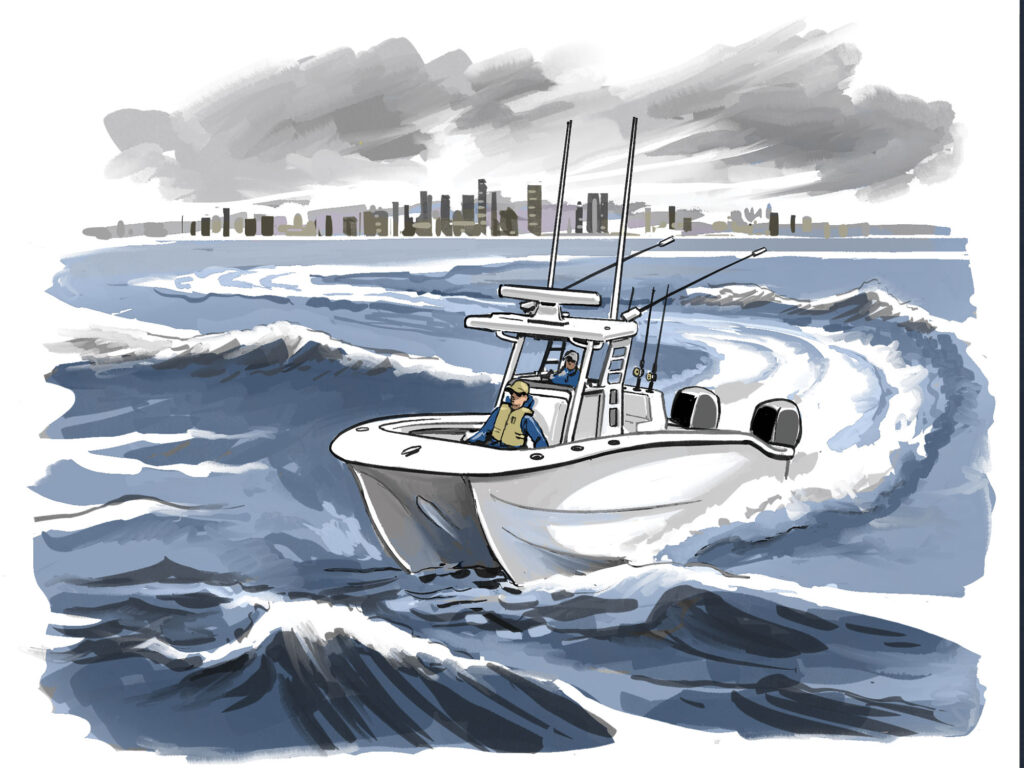
A Tale of Two Hulls
A catamaran rides on pair of hulls, or sponsons, each thinner and sharper than that of a similarly sized monohull boat. The narrow sponsons of the cat tend to slice easily through water to deliver a smooth ride, even in rough seas. At the same time, with the sponsons positioned out to the sides of the boat, cats tend to roll less, thus providing great stability to enhance crew comfort, security and safety. However, cats tend to corner more flatly than a monohull, and some hulls (but not all) tend to lean outward versus inward during a turn.
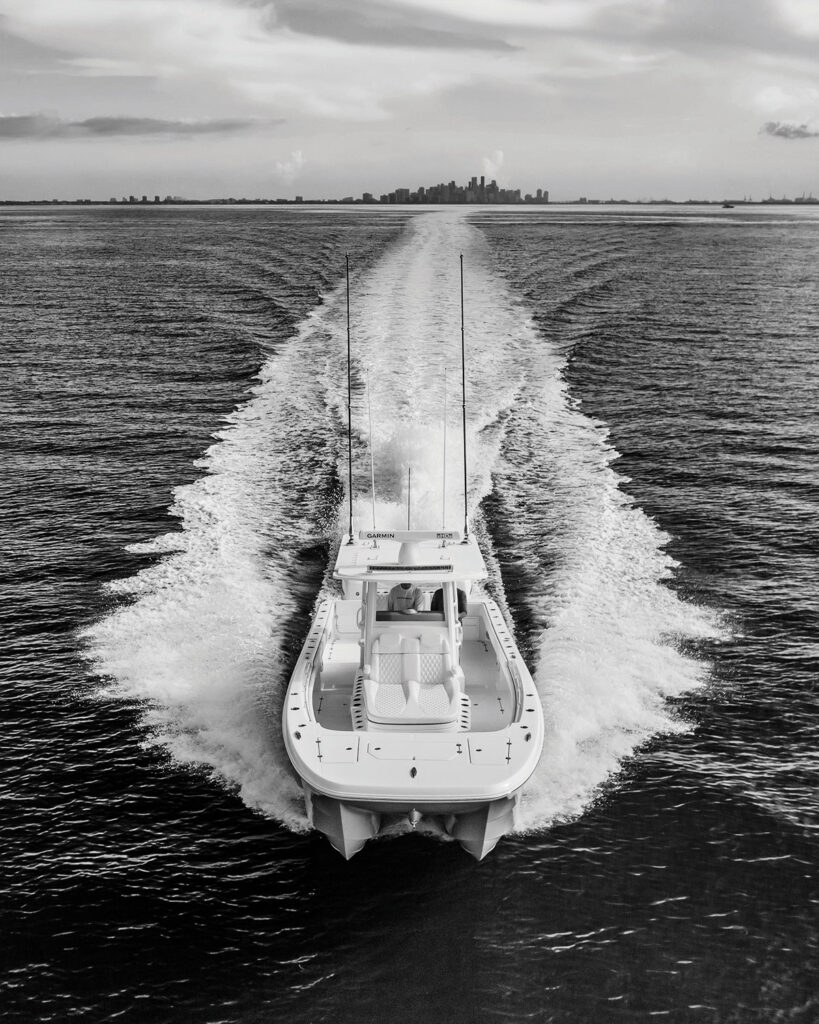
Experts Say
Newer designs such as Invincible’s Morelli and Melvin-designed semi-asymmetrical sponsons eliminate some of the negatives of the cat design, such as “sneezing,” where water sprays out the front of the boat when hitting a wave. They’ve also controlled the uncomfortable “outboard lean” sensation common in older designs when in a turn. Once transitioned to a catamaran, many become true believers and preach the benefits of the design.
Editor Says: Saltwater fishing cats not only offer superb stability and smooth ride, but some also display exceptional speed and range. I recall one trip out of Key West, Florida, aboard an Invincible 40 Cat with four 350 hp outboards to the Dry Tortugas. It was a 60-mile run, and we made it there in 70 minutes. We caught more fish than our arms could bear, and then dashed back to Key West, arriving in time for cocktail hour on the same day. -Jim Hendricks, Staff Editor, Boating and Fishing Group
- More: 2023 Boat Buyers Guide: More Resources , Boats
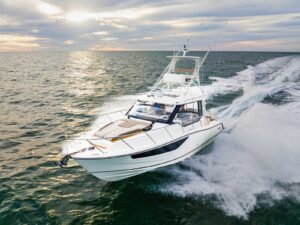
Salt Water Sportsman On Board: Boston Whaler 365 Conquest
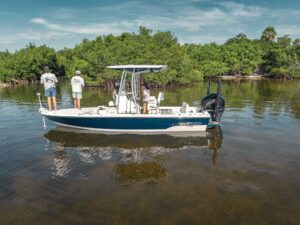
Pathfinder 2200 TRS
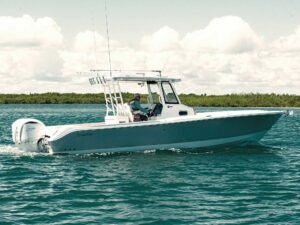
EdgeWater 325CC
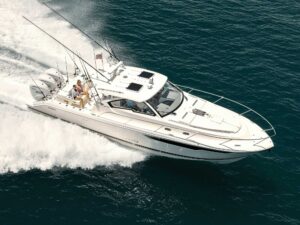
Pursuit OS 405 Offshore
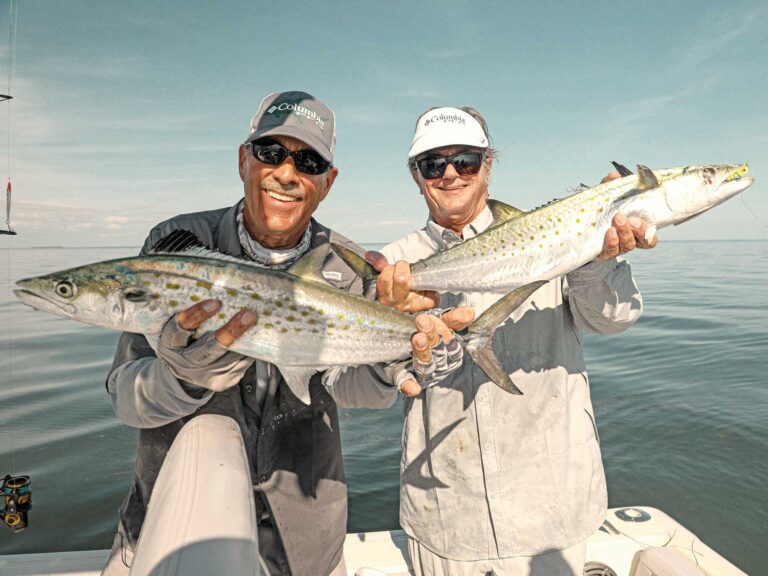
Top Spanish Mackerel Fishing Tips
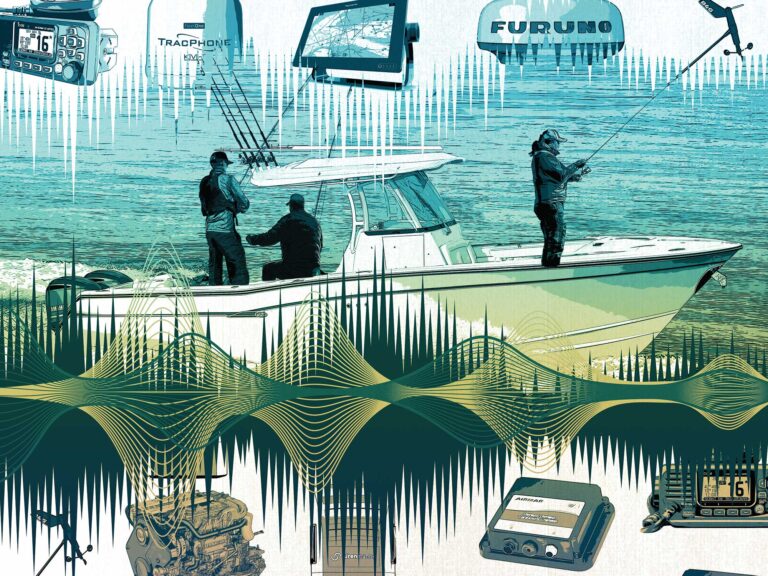
What Can Boating Anglers Expect From NMEA OneNet?
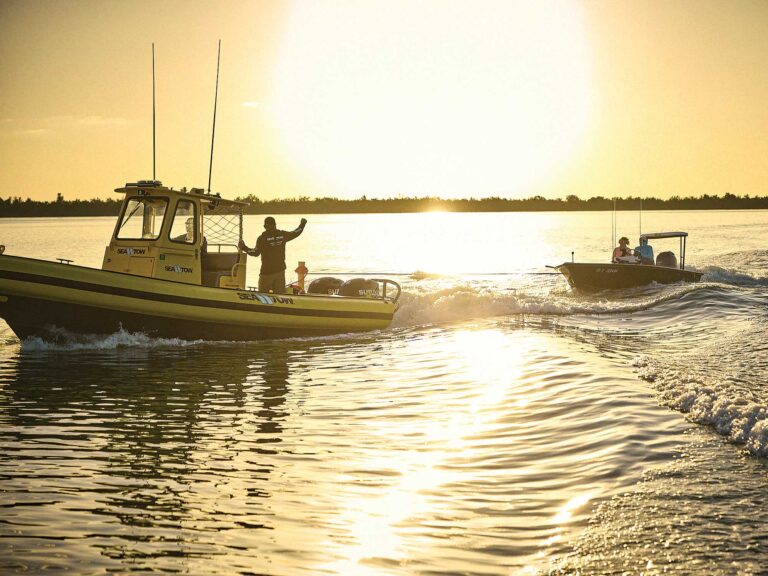
10 Common Solutions for Boat Engine Problems
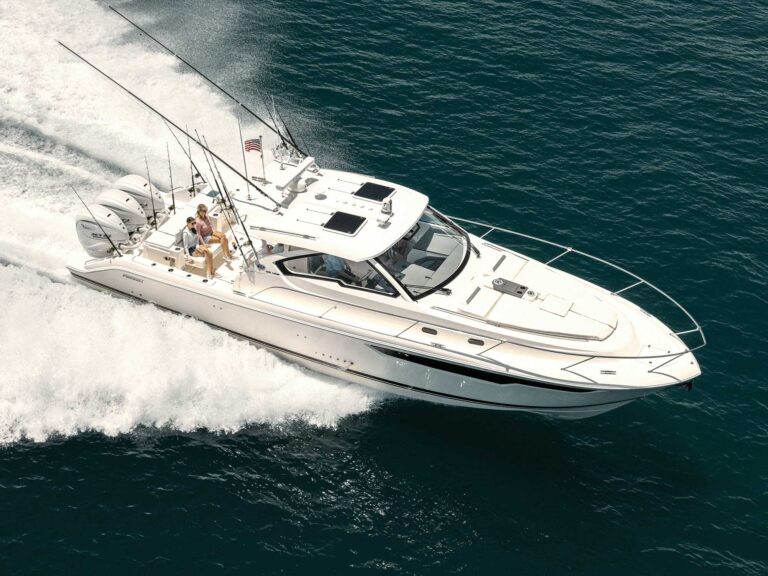
- Digital Edition
- Customer Service
- Privacy Policy
- Cruising World
- Sailing World
- Salt Water Sportsman
- Sport Fishing
- Wakeboarding

What Is A Catamaran Sailboat? (And What It Looks Like)

Last Updated by
Daniel Wade
August 30, 2022
Catamarans are increasingly popular for sailing and commercial use, but what sets them apart from monohulls and other multihulls?
A catamaran is a twin-hull boat with two equally-sized hulls placed side by side. They’re powered by engines, sails, or both—and they’re known for efficiency and speed. Catamarans are the most common kind of multihull boat.
In this article, we’ll go over the characteristics of catamarans and how to differentiate them from other types of boats. Additionally, we’ll cover the advantages and disadvantages of catamarans and compare them to trimarans and monohulls. We’ll also go over the most common types of catamarans and their uses.
We sourced the information in this article from marine design guides, boat identification resources, and the online boating community.
Table of contents
How to Spot a Catamaran
Spotting a catamaran is easy. Simply look at the hulls and count them. Catamarans have two hulls side by side and a relatively large gap between them where you can see light on the other end. Catamarans are distinct from trimarans, which have an additional hull between the two outer hulls.
How do Catamarans Work?
The principle behind the catamaran is simple. You can think of catamarans like cars and monohulls like motorcycles. Catamarans distribute their weight between hulls on either side, whereas monohulls utilize only one hull.
Evidently, cars are much more difficult to tip over and can hold much more weight. Additionally, cars are wider, as they have much more contact with the road. Catamarans work in a similar way, as they have a wide stance and contact with the surface on both sides.
Obviously, that isn’t the most precise comparison. But the basic principle is the same, and catamarans have a few notable benefits over monohulls.
Catamaran Vs Monohull
Catamarans are easy to distinguish from monohulls. A monohull is just a regular old boat with a single hull. The vast majority of boats and ships are monohulls. Catamarans have two hulls, which are usually sleek and narrow.
Here are some comparisons of catamarans and monohulls, along with the advantages twin-hull designs have over most single hull types.
Benefits of Catamarans
Catamarans have numerous benefits. The first is speed. Catamarans produce less drag than monohulls and thus can achieve excessive speeds both under sail and power. They don’t need to plane like monohulls to achieve these high speeds, and they use less fuel.
Catamarans are also much more stable than monohulls. They have a wide stance and shallow draft, and many waves and swells can travel between the hulls instead of below them. This effectively reduces an entire axis of movement and prevents catamarans from rolling excessively.
Drawbacks of Catamarans
Catamarans aren’t advantageous in every way, or else we wouldn’t bother building monohulls. The disadvantages of catamarans limit their use to niche commercial applications and high-end yachts. But what are the drawbacks of a twin-hull design?
Sailing catamarans don’t follow many of the traditional boat handling rules and characteristics that sailors pass down for generations. Some, such as hull speed limitations, are good to do away with—while others, such as responsiveness, are not.
Catamarans aren’t as quick to the helm or responsive as monohulls. There are some exceptions to this rule, but for the most part, you’ll get a lot more feedback from a single-hull vessel. Additionally, the large section of deck between the hulls of a catamaran is prone to pounding in rough seas, which is loud and uncomfortable.
Catamarans can sometimes be twice the width of an equivalent monohull sailboat, which can increase mooring fees and limit docking options.
The final major drawback of catamarans is a consequence of their stability. Traditional full-keel monohull sailboats have a very low center of gravity, which makes them roll in heavy seas but ensures a recovery.
Catamarans have a higher center of gravity, and they can’t right themselves after a knockdown. And though catamarans are less likely to roll, a severe list on a multihull is a much more serious concern than on a ballasted monohull.
Catamaran Vs Trimaran
Catamarans and trimarans are often lumped together, but they have very different design and performance specifications. Trimarans have three hulls, whereas catamarans have two.
Trimarans look a lot like catamarans from the side, but a quick glance at the bow or stern can set them apart. Trimarans are faster than catamarans, as they distribute their weight across three hulls instead of two. This helps them stay centered and reduces interference from pitching and rolling.
Catamarans are fast, but they lose out to trimarans when going head to head. However, catamarans are much less expensive to build and maintain and often have roomier cabins due to their larger hulls.
Types of Catamarans
There are numerous types of catamarans, and their uses vary widely. The catamaran is one of the oldest and most useful hull types, and some variants have been used for thousands of years. Here are the most common kinds of catamaran boats and their uses.
Sailing Catamaran
Sailing catamarans are probably what you think of when you hear the name. Sailing catamarans are sailboats with two identical hulls connected by a center deck. The largest sailing catamarans are spacious and stable vessels that are capable of serious offshore sailing.
Sailing catamarans have a number of notable advantages over monohulls. Monohulls, which are traditional sailboats with a single hull, are limited by a simple concept called hull speed. As the bow and stern wave of a monohull intersect, they cause drag which limits the top speed of the boat.
Catamarans are not bound by hull speed limitations, as they have two hulls. Catamarans can go twice or even three times as fast as similar monohulls and achieve excellent travel times.
Catamarans are also more stable than monohulls, as their wide stance and shallow draft reduce the effect of rough water. They don’t heel, as the force of the wind is counteracted by the double hulls. Additionally, modern sailing catamarans can ‘wave pierce’ by cutting through swells instead of riding over them.
Sailing catamarans come in many shapes and sizes. Small sailing catamarans, such as those used in races and regattas, are known for their speed and relative stability compared to light racing monohulls. Sometimes, they feature a smaller second hull for stability—these are called outriggers.
Sailing catamarans have spacious interiors thanks to the large cockpit between the hulls. This cockpit usually contains cooking and eating spaces, a place to sit, and a hallway between the hulls. The hulls usually contain living quarters and often mirror each other.
Power Catamarans
Power catamarans have an even greater variety than sailing catamarans. These vessels are used for everything from party platforms to ferries and patrol boats.
Power catamarans are a recent development, as engineers and marine architects now realize they have numerous hydrodynamic advantages over other hull types.
Catamarans are much more efficient than other hull types, as they have less drag relative to their size. Additionally, you can build a much larger catamaran with less material. This makes them popular for car and rail ferries, as builders can construct a very wide vessel with two small hulls rather than a narrower vessel with a large single hull.
Military and Commercial Catamarans
Even the military has found a use for the catamaran hull shape. The Spearhead class EPF is an expeditionary fast transport vessel designed for carrying capacity and speed. It has two sharp hulls and a huge cargo capacity.
The Spearhead class EPF is 337 feet long, which is about the same length as a WW2 escort destroyer. Yet despite having a similar length and displacement, these catamarans can travel more than twice as fast—43 knots, or nearly 50 miles per hour. Their great speed is a direct consequence of their catamaran hull type.
Power catamarans are also used as patrol and utility boats on a much smaller scale, with either outboard or inboard motors. The State of Texas uses catamarans to patrol shallow rivers and lakes. Texas Game Wardens utilize state-of-the-art aluminum catamaran patrol boats, which are fast enough to outrun most fishing boats.
There’s another form of power catamaran that you may not have considered. Pontoon boats are technically catamarans, and they’re enormously popular on lakes and rivers throughout the country. Pontoon boats aren’t known for speed, but they’re a great platform for a fun and comfortable outing.
Catamaran Houseboats
The final common type of power catamaran is the two-hulled houseboat. Houseboats don’t always use the catamaran hull type, but it’s common enough that most major manufacturers offer it as an option.
Catamaran houseboats have a few notable advantages over monohull designs. For one, they’re easier to build—especially when pontoons are chosen. Additionally, they’re better suited for navigating shallow water. These vessels can support more weight across their two hulls, offer increased stability, and they’re also efficient.
Why Aren’t Catamarans More Common?
With all the advantages listed in this article to consider, it may seem strange that the use of catamarans is still somewhat limited. At the end of the day, it comes down to economics—as monohull boats and ships are simply cheaper to build.
Additionally, catamarans have some distinct limitations. Monohulls have lots of storage space in their hulls and can carry thousands of tons of cargo safely in all weather conditions. Catamarans lack this space and low center of gravity, so they’re not ideal for transporting cargo past a certain point.
Additionally, monohulls work, and many people are reluctant to experiment with new designs when old designs work just fine. This rule applies to both large and small boats.
A large monohull sailboat can be constructed at low cost from stock plans and reliably sail almost anywhere. Very little complex structural engineering is involved, and looser tolerances reduce cost and maintenance requirements.
Related Articles
I've personally had thousands of questions about sailing and sailboats over the years. As I learn and experience sailing, and the community, I share the answers that work and make sense to me, here on Life of Sailing.
by this author
Learn About Sailboats
Most Recent

What Does "Sailing By The Lee" Mean?
October 3, 2023

The Best Sailing Schools And Programs: Reviews & Ratings
September 26, 2023
Important Legal Info
Lifeofsailing.com is a participant in the Amazon Services LLC Associates Program, an affiliate advertising program designed to provide a means for sites to earn advertising fees by advertising and linking to Amazon. This site also participates in other affiliate programs and is compensated for referring traffic and business to these companies.
Similar Posts


Affordable Sailboats You Can Build at Home
September 13, 2023

Best Small Sailboat Ornaments
September 12, 2023

Discover the Magic of Hydrofoil Sailboats
December 11, 2023
Popular Posts

Best Liveaboard Catamaran Sailboats
December 28, 2023

Can a Novice Sail Around the World?
Elizabeth O'Malley
June 15, 2022

4 Best Electric Outboard Motors

How Long Did It Take The Vikings To Sail To England?

10 Best Sailboat Brands (And Why)
December 20, 2023

7 Best Places To Liveaboard A Sailboat
Get the best sailing content.
Top Rated Posts
Lifeofsailing.com is a participant in the Amazon Services LLC Associates Program, an affiliate advertising program designed to provide a means for sites to earn advertising fees by advertising and linking to Amazon. This site also participates in other affiliate programs and is compensated for referring traffic and business to these companies. (866) 342-SAIL
© 2024 Life of Sailing Email: [email protected] Address: 11816 Inwood Rd #3024 Dallas, TX 75244 Disclaimer Privacy Policy

The 8 Main Characteristics of a Catamaran Hull
Posted on May 28, 2022
Ever wonder why your catamaran ride is so much smoother than other boats, including yachts? Why don’t I get as oozy as when I’m on other vessels, even when the water is choppy?
It’s all about the hull, my fellow water enthusiasts. Not just one but two hulls, positioned in such a way as to give us the most perfect ride we can get on the ocean, without us having to grow fins.
Catamarans have a wide beam, instead of a ballasted keel like a monohull vessel, which provides its steadiness. It has a more shallow draft and smaller displacement than a monohull with a similar length. Its hull offers stability, more space, privacy, no heeling, lower hydrodynamic resistance, and more.
Now that you’ve gotten the gist of it, let’s look in-depth at the hull characteristics.

1. Lower Hydrodynamic Resistance
Hydrodynamic resistance of the combined two hulls is usually lower than equivalent monohulls, needing less power from the sails or the engines. A catamaran’s broader posture on the water can decrease the feeling.
It also lessens the motions caused by waves, which can also produce smaller wakes than on a single-hulled vessel.
A cat’s hulls have a less wetted surface area, which means they burn less fuel. The boat may be propelled by one engine in mild winds.
2. Reduced Heeling

The term “heeling” refers to the tendency of a sailboat to lean to one side due to the force of the wind on its sails. The boat is oriented so that the wind hits the sails at an angle and pushes them to one side of the boat, propelling the boat.
Catamarans are the safest way to navigate the oceans because they have no heel angle. Cruising catamarans are safer than monohulls for their crew because they offer better protection and a no-heel environment.
As a result, the crew will be less exposed, make fewer mistakes due to exhaustion, and arrive at their destination more rested.
3. Less Displacement
Boats that employ buoyancy to support their weight are referred to as displacement hulls. To provide its name, it is partially immersed and moves by causing water to be dislodged.
Its weight is equal to the amount of water it dispenses. In stormy water, it maintains its sturdiness. As a result, cruisers and sailboats alike frequently make use of this design.
4. Stability

In place to evade capsizing as well as heeling, the catamaran depends on hull stability, while hull stability depends on buoyancy and beam. About half of a typical cruising catamaran’s length is its beam.
Say, for example, that the boat was 50 feet in length, the beam might be about 25 feet broad so that you could maintain the balance between heel and righting moment.
On a cat, passengers who are prone to motion sickness will be far less affected by the impacts of motion than they would be on a monohull. The cook’s task is made much easier while traveling and at anchor because of the cat’s extra stability. When compared to monohulls, catamarans have less rock and roll.
Once you’ve decided to sail, you won’t have to worry about scrambling to stow things or securing them with bungee cords. Relatively rough seas have little effect on most of the ship’s equipment.
5. A Bridgedeck Connects Them

You can’t ignore this reality! Bridgedeck clearance, or the gap between the water and the bridge deck, is an important factor in a catamaran’s safety and reliability. Ocean waves have room to flow between the hulls thanks to the bridge deck clearance.
Our catamaran’s hulls create waves that converge underneath the bridge deck, requiring a larger buffer for the bridge.
If you don’t have enough clearance, your catamaran will be pounded by the waves.
In addition to slowing your catamaran down by 3 to 4 knots, rough seas can also put your guests’ health and safety at risk, as well as inflict significant damage to your boat and rigging.
6. Can Maneuver Shallow Water
A boat’s draft is the distance from the water’s edge to the hull’s center of gravity. It is important to know the depth of a boat’s draft since it determines the quantity of water that can be displaced for safe passage. As a result of their parallel hulls’ buoyancy, catamaran vessels can have fewer drafts without affecting their stability or their ability to maneuver.
When it comes to hull stability and handling, monohull vessels are built with a deeper draft to protect against capsizing as well as heeling. Because of this, the catamaran was deemed suitable for use in shallow waters.
Boating activities such as swimming and fishing aren’t the only ones that benefit from being able to dock in shallow water. A boat with a shallow draft will be more maneuverable in areas where you may have to sail through a variety of shallow areas, some more than others.
Monohull boats with deeper drafts may be unable to access shores, intertidal zones, coral reefs, or even sandbars because of their shallower depths. Also, shallow-water swimming and snorkeling are two of the most popular pastimes for sailors plus their families. To ensure a smooth experience, you’ll need secure access to shallow waters.
There are several types of fishing that require a catamaran’s dependability and readiness, and these include trout, oystering, and clamming. These activities become much easier when you can navigate shallow waters without worrying about running aground or striking underwater objects.
7. Allows Cat to Have More Space
It certainly does. Eating and preparing food can be done side by side. One hull is used as a big cabin in the “owner versions,” which are fantastic for parties.
Most comparable-priced monohulls lack the amount of interior room seen on catamarans, especially in the primary salon, galley, plus cockpit. As a result, their cabins tend to be larger, and now even the tiniest cat in the group has a stand-up headroom in each one.
8. Offer More Privacy
The distance between the two hulls allows for greater privacy than on monohull yachts, which tend to be closer together.
Because of the configuration, a cat offers more solitude than monohulls, and the increased separation between the main living area and the cabins makes it simpler for children to go off to sleep at a normal hour when aboard.
What Are the Differences Between Catamaran and Monohull Sailing?

Most characteristics of sailing a catamaran resemble those of sailing a monohull. In most Catamaran Sailing Boats, the abilities you acquire on a monohull, you can transfer to a cat. A few minor distinctions must be made though, including these.
Keep a steady speed during the tack to avoid “winning,” which can occur if you relax the mainsheet too much. Winning occurs when a catamaran’s larger mainsail tries to direct the boat towards the direction of the wind.
Gybing on the monohull necessitates much more caution, therefore you have to slow down your gybe considerably. Travelers on catamaran boats have an advantage since they can sustain a pace while gybing to depower the main.
You can tell when you’ve got too much sail on a monohull by the way the boat is heeling, which tells you it’s time to reef. Since catamarans don’t heel, we have to be super cautious when reefing the enormous mainsail because it’s so heavy.
In most cases, the first reef will be thrown in between wind speeds of 18 and 20 knots (determined by the size of our yacht) and the second reef will be thrown in as the wind speeds reach up to 25 knots.
Many elements of sailing a catamaran are fairly similar to those of a monohull, so making the switch should not be too difficult.
Are Catamarans Safer Than Monohulls?

Exactly what I was looking for! People are less likely to drown when sailing on a catamaran than on a monohull, thanks to the boat’s greater stability. They are bigger, more steady vessels. In most cases, this makes cats “safer” than a monohull of the same size.
Having two engines makes catamarans “safer” in the event of an engine breakdown. Sailing is the sole alternative on a monohull boat if the motor is out of commission. In the event of an emergency, the second engine on a catamaran is always ready to assist!
Is Sailing A Catamaran Easier Than Sailing A Monohull?
It is more difficult to sail a monohull because of heeling and the constrained space it has to offer. In greater gusts, monohulls heel, making it harder to accomplish most activities.
Sailing aboard a heeling vessel is more difficult for a variety of reasons, including heading forward to a reef, having to haul in a sail, or just moving around the boat.
The greater stability and space provided by catamarans, on the other hand, make moving around the boat easier than on other types of boats. The fact that catamarans are typically referred to as “easier” to sail is due to this.

Semi-custom Catamarans
About falcon boats, with decades of experience in composite design, tooling, manufacturing, and naval architecture, the falcon team in 2019 decided it was time to build and brand our own line of unique power semi-custom catamarans..
VACUUM INFUSION BENEFITS: Controlling costs during the build process without compromising the integrity, utilizing state-of-the-art composites, infusing the build of each hull, deck, and components throughout the entire build. A significantly stronger assembly versus heavy hand lamination.
Related Video

Excitement, Performance, & Comfort comes standard.
From years of experience in repairing, running, and building other brands of boats, the Falcon team knew they could develop a superior product. We have developed layouts, features, and improved manufacturing technology that result in a build quality that sets Falcon Boats apart. People who really use their boats will appreciate the difference!
Get started with Falcon!

Quick links

- Motorcycles
- Car of the Month
- Destinations
- Men’s Fashion
- Watch Collector
- Art & Collectibles
- Vacation Homes
- Celebrity Homes
- New Construction
- Home Design
- Electronics
- Fine Dining
- Baja Bay Club
- Costa Palmas
- Fairmont Doha
- Four Seasons Private Residences Dominican Republic at Tropicalia
- Reynolds Lake Oconee
- Scott Dunn Travel
- Wilson Audio
- 672 Wine Club
- Sports & Leisure
- Health & Wellness
- Best of the Best
- The Ultimate Gift Guide
- This New 131-Foot Catamaran Comes With See-Through Hulls
Tecnomar has followed up one polarizing multihull with another.
Rachel cormack.
Digital Editor
Rachel Cormack's Most Recent Stories
- This New 131-Foot All-Aluminum Superyacht Lets You Take a Dip at Tip and Tail
- This 92-Foot Yacht Has a Deck Big Enough for Your Chopper
- Share This Article

Tecnomar just unveiled the spiritual successor to the feather-ruffling 143-foot catamaran This Is It .
Related Stories
- This New 131-Foot Aluminum Catamaran Concept Can Take on a Transoceanic Expedition
- This New 89-Foot Custom Catamaran Has Its Own Nap Station on the Flybridge
- Rafael Nadal's Favorite Catamaran Builder Is Opening a New Yard in the UAE

Another highlight of Cat 133 is the stern: Two hulls, two internal wings, and two foldable side doors come together to create a swimming platform that is about 52 feet wide when fully opened. This Is It , on the other hand, has more of an enclosed aft deck and two fixed swim platforms.
The interior details of Cat 133 have not yet been shared, but the vessel will be able to accommodate up to 10 guests and 11 crew. This Is It sleeps a total of 12 guests and 12 crew in a bright asymmetric interior with skylights and floor-to-ceiling windows aplenty. As for amenities, This Is It features an indoor cinema, a curved cocktail bar, a spa, a playroom, and a two-level vertical garden. Hopefully, Cat 133 is also blessed with some of those glitzy features. (The renders show it has a small infinity pool on the aft of the upper deck, at least.)
Regarding power, the newcomer is equipped with twin MAN V-12 engines and two 50 kW electric bow thrusters that enable a maximum speed of 17 knots and a cruising speed of 15 knots. This Is It is a hair quicker, with the ability to hit 21.5 knots at full tilt or cruise at 20 knots.
Something Cat 133 has that This Is It does not is the ability to generate clean, green power: Roughly 750 square feet of solar panels are integrated into the cat’s superstructure arches and hardtop. Cat 133 is certainly smaller than This Is It , but it may be more sustainable.
Rachel Cormack is a digital editor at Robb Report. She cut her teeth writing for HuffPost, Concrete Playground, and several other online publications in Australia, before moving to New York at the…
Read More On:
- The Italian Sea Group

Ryan Reynolds and Rob McElhenney Bought a U.K. Soccer Club in 2021. It Now Owes Them $11 Million.

Kim Kardashian Is Being Sued By the Judd Foundation. Here’s Why.

‘Crazy Rich Asians’ Alum Henry Golding Is Joining ‘Nine Perfect Strangers’ Season 2

Everything We Know About ‘The Bear’ Season 3′ So Far

Culinary Masters 2024
MAY 17 - 19 Join us for extraordinary meals from the nation’s brightest culinary minds.
Give the Gift of Luxury
Latest Galleries in News

The History of Luxury in 50 Objects, From Cleopatra’s Barge to Louis Vuitton Trunks

The 25 Best Robb Report Stories of the Year, According to Our Editors
More from our brands, bitmoji is coming for your pets, kobe bryant’s 2000 ring sets record price for nba title ring, box office: ‘oppenheimer’ opens in japan with $2.5 million, christie’s secures sale of $30 m. de la cruz collection, the best exercise mats for working out, according to fitness experts.

NS Energy is using cookies
We use them to give you the best experience. If you continue using our website, we'll assume that you are happy to receive all cookies on this website.

We have recently upgraded our technology platform. Due to this change if you are seeing this message for the first time please make sure you reset your password using the Forgot your password Link .
Goschen Mineral Sands and Rare Earths Project, Australia
The Goschen Mineral Sands and Rare Earths project is the flagship project of Australia-based company VHM. The project,…
Mining Other Commodities Rare Earth Metals

Smørbukk Nord Development, Norwegian Sea
The Smørbukk Nord Discovery is an offshore gas and condensate discovery located in the Norwegian Sea. It is…
Oil & Gas Upstream Offshore

Manah-1 Solar Power Plant, Oman
Manah-1 is a solar photovoltaic (PV) independent power plant (IPP) being developed in Al Dakhiliyah Governorate, Oman.
Power Solar PV
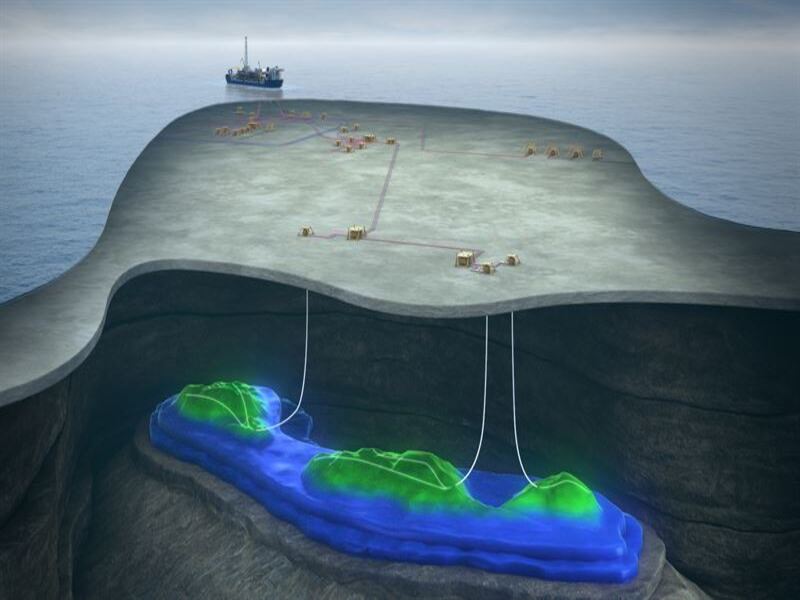
Tyrving Development, Norway
Tyrving Development (previously Trell and Trine fields) is located in the Heimdal Terrace area of the North Sea,…

Santo Tomás Project, Mexico
The Santo Tomás Project is an open pit mine hosting a porphyry copper deposit with fractured and disseminated…
Mining Industrial Minerals

Aldbrough Hydrogen Pathfinder Project, UK
The Aldbrough Hydrogen Pathfinder Project is a proposed electrolytic hydrogen production, storage, and energy generation facility in the…
Power Clean Technology
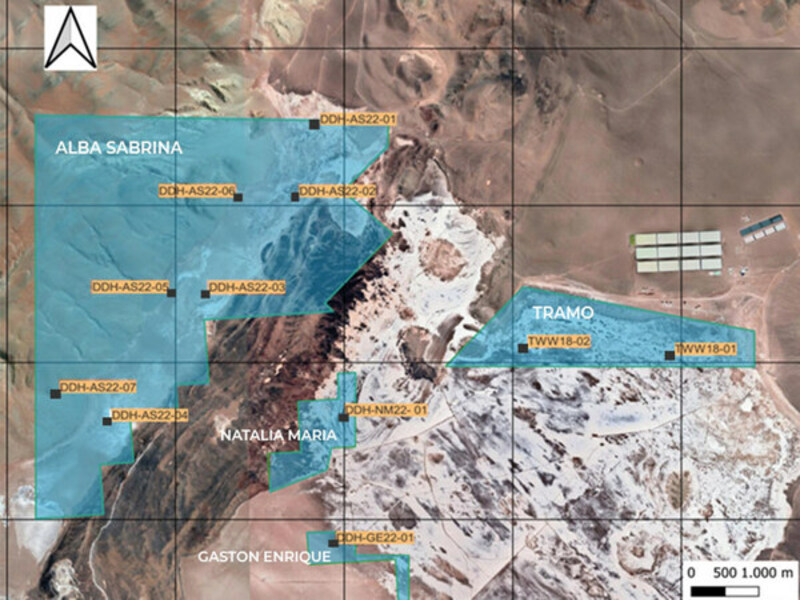
Hombre Muerto North Project, Argentina
Hombre Muerto North Lithium Project (HMN Li Project) in Salta Province, Argentina, is being developed by its 100%…
Mining Other Commodities Industrial Minerals
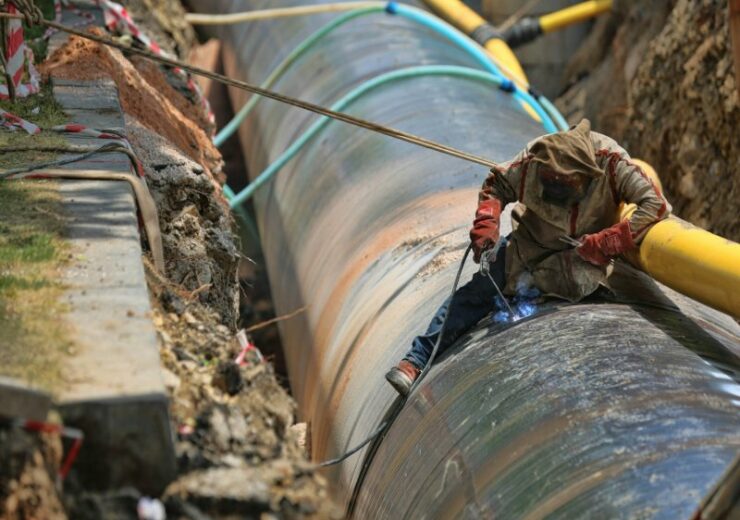
Kurri Kurri Lateral Pipeline, Australia
The Kurri Kurri Lateral Pipeline (KKLP) is a gas transmission and storage pipeline being developed in New South…
Oil & Gas Midstream Pipeline
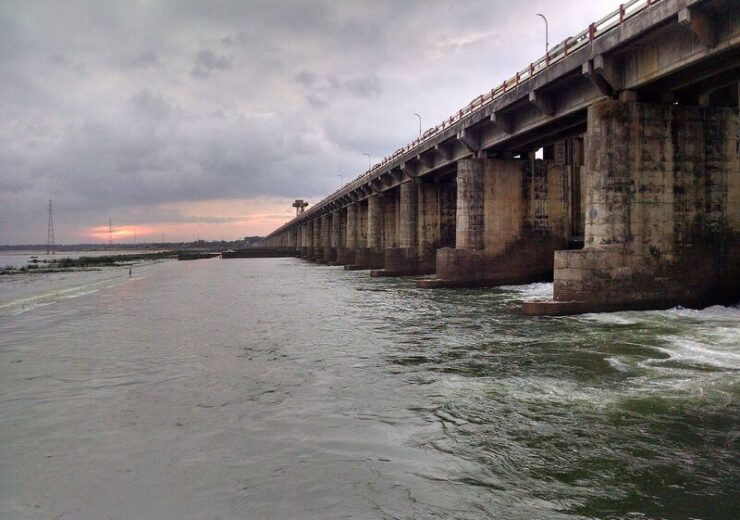
Chitravathi Pumped Storage Project, India
The Chitravathi Pumped Storage Project is a proposed 500MW/2,805MWH pumped storage hydroelectric scheme in Sri Sathya Sai/Kadapa District…
Power Hydro Pumped Storage
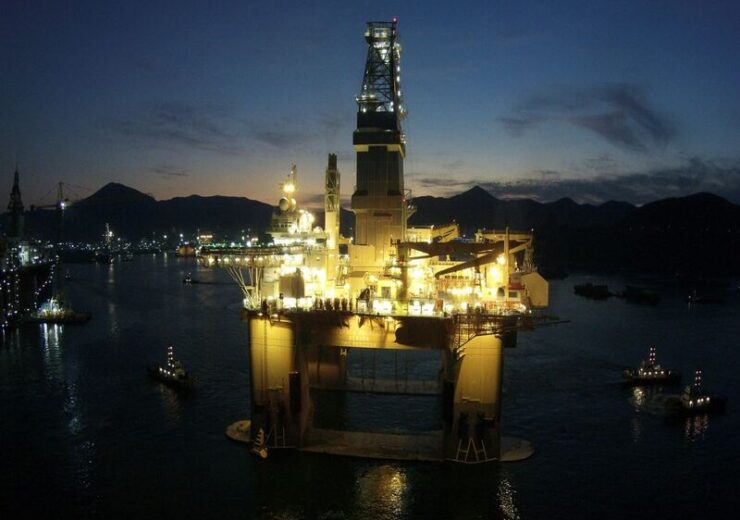
Bergknapp Discovery, Norwegian Sea
Bergknapp offshore oil and gas discovery is located within the PL836S licence in the Norwegian Sea.
- FightCenter #
- Sparta Championship... Sparta Championsh...
- Soltabiev vs. Kalb Soltabiev vs. Kalb
Abubakar Soltabiev vs. Chris Kalb

Fighter Comparison
Soltabiev vs. kalb fight predictions, fight predictions, tapology community picks: 0, bout information, event poster.

Fight Details
- Event: Sparta Championship Fighting 4
- Date: Saturday 04.27.2024 at 12:00 PM ET
- Referee: N/A
- Venue: Multiversum Schwechat
- Location: Schwechat, Austria
- Bout Billing: Main Card
- Pro/Am: Professional
- Weight: 145 lbs (65.8 kg)
Event Discussion
Regional rankings, schedule & news

Claim your page
• All the biggest upcoming MMA & Boxing fights
• Create a free Tapology account to play
• Rank fighters & bouts in each division
• Create a free Tapology account to begin
Create an account and see fewer ads on Tapology.
• Update Fight Cards, Fighter Bios, Gym Info.
• Get Website Support, Advertising, Other inquiries.
Soltabiev vs. Kalb
Submit a dispute for this result of this fight.
Charalampos Grigoriou is 32 today! Send him a Tweet.
- Bad Left Hook : Wardley vs Clarke: Live updates and results
- MMA Junkie : UFC 302 official for Newark on June 1; multiple fights announced
- Bad Left Hook : Wardley vs Clarke: Live updates and results NOW!
- MMAFighting.com : Bo Nickal calls Olympic gold medalist Jordan Burroughs a ‘freaking fraud’ following wrestling dispute
- Jits Magazine : Baret Yoshida Becomes First ADCC Hall Of Famer To Compete At ADCC Trials
- MMA Junkie : 5 biggest takeaways from UFC on ESPN 54: How was Chris Weidman's controversial win NOT changed to a no contest?
- MMAFighting.com : Erin Blanchfield releases statement after blowout UFC Atlantic City loss
- MMA Junkie : UFC on ESPN 54 winner Nate Landwehr open to Bryce Mitchell matchup: 'That would be a good one'
- Middle Easy : Chris Weidman Addresses Eye Pokes In Controversial Win Over Bruno Silva, Pauses Retirement Plan
- MMAFighting.com : Bruno Silva to appeal UFC Atlantic City loss, says Chris Weidman ‘acted in bad faith’ with multiple eye pokes
- MMA Junkie : UFC on ESPN 54 post-event facts: Strange event matches all-time TKO record
- MMA Mania : Urijah Faber Vs. Jeff Curran 2 Booked For May 25
- MMA Junkie : Joaquin Buckley set on making UFC change St. Louis headliner – to himself vs. somebody
- MMA Junkie : Joaquin Buckley set on making UFC change St. Louis headliner – to him
- MMAFighting.com : Chris Weidman reacts to controversial win over Bruno Silva: ‘Was he looking for a way out? I don’t know’
- MMA Junkie : Chris Weidman doesn't plan to retire after UFC on ESPN 54 win: 'I still think I have it'
- MMA Mania : UFC Atlantic City, The Morning After: When In Doubt, Poke ‘Em In The Eye!
- Bad Left Hook : Wardley vs Clarke: Live updates and results, 1 pm ET
- MMAFighting.com : Georges St-Pierre recalls surviving close encounter with silverback gorilla
- MMA Junkie : UFC on ESPN 54 Promotional Guidelines Compliance pay: Program total passes $24.5 million
Tapology Team · Contact Us · Add Results · FAQ · Terms of Use · Privacy
Tapology Team · Contact Us · Add Results
FAQ · Terms of Use · Privacy
Facebook · Twitter · Instagram
© 2024 Tapology.

IMAGES
VIDEO
COMMENTS
Find Sail Catamaran boats for sale in your area & across the world on YachtWorld. Offering the best selection of boats to choose from. ... Listed hull types include catamaran, trimaran, displacement, monohull and other. Constructed by a wide variety of yacht makers, YachtWorld presently offers a selection of 1,821 catamaran yachts for sale ...
Hulls are what sets this boat apart from the rest. The catamaran has two hulls, while the monohull, as the name suggests, has only one hull. Most of the advantages of this boat are hinged on these two hulls. The bridge deck connects the two catamaran hulls. On top of the catamaran hulls and the bridge deck is the deck.
There are a wide range of Catamaran boats for sale from popular brands like Fountaine Pajot, Lagoon and Bali with 493 new and 1,467 used and an average price of $563,023 with boats ranging from as little as $67,364 and $6,732,541. Catamarans. Are two hulls better than one? Many people who own sailing catamarans certainly think so.
Photo via World Cat Boats. World Cat is one of the most recognizable brands in the world of power catamarans — in fact, according to the company they're the largest producer of power catamarans in the world. Their line is a mix of center console and dual console fishing and family boats ranging from 23' to 40'.
The hull design that changed catamarans forever, taken to a whole new level. The ultimate offshore fishing machine, with unprecedented size, range and amenities to carry everyone and everything anywhere, in any conditions. ... There are a wide range of Power Catamaran boats for sale from popular brands like World Cat, Twin Vee and Aquila with ...
But since most multihulls have similar Depth/WL beam ratios you can pretty much say the SLR equates to the LWL/BWL ratio. Typically this will be 8-10:1 for a slow cruising catamaran (or the main hull of most trimarans), 12-14:1 for a performance cruiser and 20:1 for an extreme racer. So by and large faster boats have finer hulls.
The two hulls of a power catamaran are designed to cut through waves with less drag, thus increasing fuel efficiency and ride comfort. Many modern power catamarans are built with stepped hulls and utilize vented hull technology. ... Power Catamaran boats listed for sale on YachtWorld offers a diverse price range, from $37,790 on the relatively ...
A catamaran rides on pair of hulls, or sponsons, each thinner and sharper than that of a similarly sized monohull boat. The narrow sponsons of the cat tend to slice easily through water to deliver a smooth ride, even in rough seas. At the same time, with the sponsons positioned out to the sides of the boat, cats tend to roll less, thus ...
A catamaran is a twin-hull boat with two equally-sized hulls placed side by side. They're powered by engines, sails, or both—and they're known for efficiency and speed. Catamarans are the most common kind of multihull boat. In this article, we'll go over the characteristics of catamarans and how to differentiate them from other types of ...
These boats are constructed by a wide variety of boat builders with hull types including catamaran, deep vee, pontoon, modified vee and semi-displacement designs. A total of 292 brand-new boats and 391 used boats are among the 683 power catamaran boats that are now available on Boat Trader, which features listings from both professional boat ...
A catamaran's broader posture on the water can decrease the feeling. It also lessens the motions caused by waves, which can also produce smaller wakes than on a single-hulled vessel. A cat's hulls have a less wetted surface area, which means they burn less fuel. The boat may be propelled by one engine in mild winds. 2. Reduced Heeling
The entire boat has been refined to integrate the latest features, technology and performance that HH Catamarans is known for. On the interior, the layout has been improved to feature a more social layout with twin, L-shaped sofas, seating on all four sides of the cockpit, a more modern island galley, and large forward opening salon windows improve ventilation throughout the boat.
Power catamarans are typically more fuel-efficient than monohull boats of the same size. It requires less energy and yields more performance per HP. The two hulls create little to no drag or resistance to get on plane, resulting in greater fuel economy. Allowing for longer journeys with fewer refueling stops.
The Cape Fear Cats team of artisans is invested in seeing your boat all the way through from design to delivery. Our in-house welders, fabricators, riggers, and painters are able to build your boat 100% on site. We craft all of our 100% aluminum boats to your specific design. Our commercial strength hulls will provide you a top of the line ...
About Falcon Boats. With decades of experience in composite design, tooling, manufacturing, and naval architecture, the Falcon team in 2019 decided it was time to build and brand our own line of unique power semi-custom catamarans. VACUUM INFUSION BENEFITS: Controlling costs during the build process without compromising the integrity, utilizing ...
Catamaran sailing vessels are manufactured by a wide variety of boat builders with hull types including catamaran, monohull and trimaran designs. These sailboats have a minimum total sail area of 218 square feet, a maximum total sail area of 3,630 square feet and an average of 968 square feet. ... Catamaran sailing vessels for sale on Boat ...
This New 131-Foot Catamaran Comes With See-Through Hulls Tecnomar has followed up one polarizing multihull with another. Published on March 27, 2024. By Rachel Cormack. Rachel Cormack
Find company research, competitor information, contact details & financial data for ZAIMILK, OOO of Zainsk, Tatarstan (Republic) (Tatarstan). Get the latest business insights from Dun & Bradstreet.
2008 Alubat 24. US$1,626,193. ↓ Price Drop. Yachts for Sale BCN SL | barcelona, Barcelona. Request Info. <. 1. 2. Find Power Catamaran Aluminum boats for sale in your area & across the world on YachtWorld.
Estimated to cost £394m ($514m), the proposed combined-cycle power plant is intended to replace some of the ageing steam units of the existing plant to reduce natural gas consumption and harmful emissions.. The Zainskaya SDPP expansion project is being undertaken as part of the national modernisation programme of old thermal power plants by the Ministry of Energy of the Russian Federation.
Zainsk, Respublika Tatarstan. Russia | Wheels. Avtozavodskaya 11 Zainsk, Respublika Tatarstan 423520. Phone: +7 85558 28 101. Get Directions. With property covering over 330,000 square meters, 600 Accuride Wheels Zainsk employees manufacture steel wheels for Commercial Truck, Light Commercial and Passenger vehicles.
Middle Easy: Corey Anderson Outwrestles Karl Moore To Win Vacant Title - Bellator Belfast Results (Highlights) ; MMA Junkie: Bellator Champions Series: Belfast results: Patricio Freire swarms Jeremy Kennedy, calls for UFC, PFL title fights ; MMA Mania: UFC Vegas 89 - New Blood!; Middle Easy: Patricio Pitbull Batters Jeremy Kennedy In Incredible Comeback, Retains Title - Bellator Belfast ...